
Case Report
Phys Med Rehabil Int. 2014;1(3): 4.
Gait Training for Becker's Muscular Dystrophy Using Robot Suit Hybrid Assistive Limb
Asai T1, Ojima I1 Minami S1 Takeshima Y2 and Matsuo M1 3*
1Department of Physical Therapy, Kobegakuin University, Japan
2Department of Pediatrics, Hyogo College of Medicine, Japan
3Kobe University, Japan
*Corresponding author: Matsuo M, Department of Physical Therapy, Kobegakuin University, Japan
Received: October 03, 2014; Accepted: October 12, 2014; Published: October 14, 2014
Abstract
Becker's muscular dystrophy (BMD) is an X-linked recessive inherited disorder characterized by a slow and degenerative muscle weakness of the legs and pelvis. The patients eventually use walking aids or are wheelchairbound in daily life because of the progression of disability. The robot suit hybrid assistive limb (HAL) is a new robot suit designed to assist voluntary control of lower limb motion by detecting extremely weak bioelectric signals on the skin surface. Here we report how HAL gait training can be adapted for a wheelchairbound patient with BMD. A 25-year-old patient with BMD participated in HAL gait training.Gait training consisted of three phases: phase 1, adaptation of HAL for the patient; phase 2 (1 year), treadmill training with the body-weight supported walker (BWSW); and phase 3 (2 years), gait training on the floor with the BWSW. The subject completed 2 h of HAL gait training once a week (from August 2011 to August 2014). Although there are no standard exercises for patients with BMD, his gait ability and fitness improved, following HAL gait training. This result indicates that HAL gait training can be both feasible and safe when used as a part of a regular rehabilitation program for patients with BMD. Harness use seems to be essential for safety and feasibility of HAL gait for patients with BMD. The combined use of the HAL gait training and BWSW may be an effective rehabilitation tool for patients with BMD.
Keywords: Becker's muscular dystrophy; Hybrid assistive limb; Gait exercise; Body-weight supported walker
Introduction
Becker's muscular dystrophy (BMD) is an X-linked recessive inherited disorder, characterized by a slow and progressive degenerative muscle weakness of the legs and pelvis. Severity of the disease may markedly vary depending on the age of the patient at disease onset [1]. The patients eventually use walking aids or are wheelchair-bound in daily life because of progression of disability [2]. Rehabilitation exercises differ for ambulatory and wheelchair-bound patients. Gait training, activities of daily living (ADL) exercises and conventional physical therapy (stretching and range of motion at the lower limb joints) are practiced for ambulatory patients. Once patients become wheelchair-bound, gait training is no longer practiced; rehabilitation efforts instead focus on ADL exercises to maximize independent living.
The robot suit hybrid assistive limb (HAL) is a new robot suit designed to assist voluntary control of the knee and hip joint motion by detecting extremely weak bioelectric signals on the surface of the skin [3-5]. The HAL can support the wearer's lower limb motion while walking by adjusting the supportive level [3]. The HAL gait training is being increasingly employed for patients suffering from acquired neurological disease, such as stroke or spinal cord disease [4-9]. However, no studies have attempted to examine the feasibility of HAL rehabilitation for patients with BMD. Here we report a case in which the patient was wheelchair-bound and rehabilitation gait training had ceased. We report how HAL gait training can be adapted for use by a wheelchair-bound patient with BMD. Gait ability was influenced by HAL training.
Case Presentation
A 25-year-old patient with BMD (height, 164 cm; weight, 54 kg) participated in HAL gait training. He was diagnosed with BMD by dystrophin immune-staining of biopsied muscle tissue at 9 years of age because of the appearance of motor function deficits [10]. After the onset of BMD symptoms, his physical function gradually declined, and he began using a wheelchair outdoors at the age of 15. At the age of 22, walking was no longer possible. From the age of 23, he participated in conventional physical therapy, including muscle strength and range of motion exercises, twice a week in preparation for HAL gait training. At the age of 25, he started HAL gait training in addition to conventional physical therapy. Prior to participating in HAL gait training, the subject provided informed consent; the study was approved by the Ethics Committee of the Kobegakuin University (HEB121211-1).
Mode Setting of HAL
The HAL has a hybrid control system consisting of Cybernic Voluntary Control (CVC) and Cybernic Autonomous Control (CAC) [9]. The CVC supports the patient's voluntary lower limb motion according to the voluntary muscle activity and assistive torque provided to each joint. In this study, we used the CVC, which allows the operator to adjust the degree of physical support to the patient's comfort. In addition, the HAL has two modes, walking mode and stand up mode, which support voluntary movement of walking and standing up, respectively, according to the electrical signals of muscle contracture and load on the feet. In this study, we used the walking mode for gait training and stand up mode for sit-to-stand exercises. Furthermore, we monitored the heart rate during gait training to ensure that the working load was safe and appropriate.
Training
Gait training consisted of three phases: phase 1, adaptation of HAL for the patient; phase 2, treadmill training with the body-weight supported walker (BWSW); and phase 3, gait training on the floor with the BWSW. Typical gait training (phases 1 and 2) proceeded as follows: attaching electrodes, wearing the HAL and harness, and setting up the computer (45 min); HAL gait training (60 min, including rest time); removing the HAL and harness (15min). In phase 3, five sit-to-stand exercises (5STS) were added after gait training. All gait trainings and 5 STS were conducted by three physical therapists. The training phase is summarized in Table 1.
Phase 1
Adaptation of HAL suit for patient
Phase 2 (1 year)
Treadmill training with BWSW
Phase 3 (2 years)
Gait training on the floor with BWSW
- Search for the body parts to detect the bioelectrical signal for hip extension.
- Apply the special harness to BWSW.
- 2 h of training once a week (gait training: 1 h).
- The treadmill speed was adjusted to patient's condition
(0.6-1.6 km/h)
- The gait speed of the treadmill and the walking distance during training increased (the distance that the patient walked before the heart rate reached 125 bpm).
- 2 h of training once a week (gait training: 1 h)
- Walking speed was adjusted by a therapist to pull the BWSW but not exceeding the heart rate of 125 bpm.
- Walking distance during training increased (the distance that the patient walked before the heart rate reached 125 bpm).
- 5 times sit-to-stand exercise after gait training
Table 1: Summary of gait training.
Phase 1: Adaptation of HAL suit for the patient
According to the manufacturer's instructions, electrodes for the hip extension were attached just below the ischial tuberosity. However, sufficient electrical signals of muscle contraction were not detected in this area. Several electrodes were placed on different sites around the hip joints, and an area on the upper part of the gluteus maximus muscle was found to enable bioelectrical signal detection (Figure 1). When applying the HAL, we used BWSW to adjust the working load (Figure 2). BWSW is a modified body support system, which has been used for the HAL gait training for patients with stroke and spinal cord injury [9, 11]. A HAL supplier-recommended special harness in the BWSW was used for the patient (Figure 3A). We were able to adjust the height of patient from the floor using a handle on the outside of the frame (Figure 3B). In addition, this system can be set up to be used with a treadmill or as a special walker on the floor (Figure 4, 5).
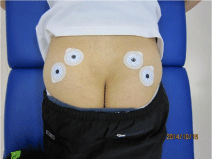
Figure 1: Locations of electrodes for hip extension.
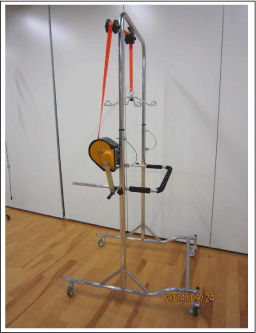
Figure 2: Body-weight supported walker.
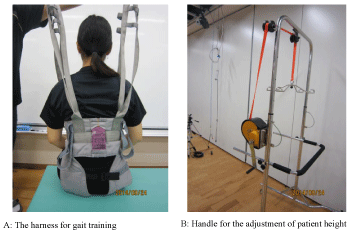
Figure 3: Treadmill training with the BWSW with harness.
BWSW: body-weight supported walker
A: The harness for gait training,
B: Handle for the adjustment of patient height
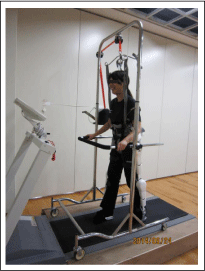
Figure 4: Treadmill training with BWSW.
BWSW: body-weight supported walker.
Phase 2: Treadmill training with BWSW
In this phase, the subject under went 2 h of HAL gait training once a week for 1 year (Figure 4). The treadmill speed was adjusted to the patient's condition. The subject could not continue walking with HAL so much after his heart rate reached at 125 bpm. For the safety reason, 125 bpm was set as the discontinuance criteria for the HAL gait training. The treadmill speed and walking distance during the training was the speed and distance before his heart rate reached at 125 bpm, and they were gradually increased (Figure 6). We started with a treadmill speed of 0.6 km/hr and walking distance of 200 meters, because he felt the difficulty of walking with HAL in the begining and his heart rate reached at 125 bpm very easily. Near the end of phase 2, the subject could walk at a speed of 1.6 km/h and walk a distance of >700 meters. Additionally, the subject walked on the treadmill with 1-3° incline in the last 100 meters when his condition was good. His average heart rate was approximately 110 bpm during walking.
Phase 3: Gait training on the floor using the BWSW
After phase 2, we began gait training on the floor (Figure 5). Walking speed was adjusted by a therapist to pull the BWSW but not exceed a heart rate of 125 bpm. The initial walking distance during training was less than 200 meters, but it was gradually increased to approximately 500 meters (Figure 6). After gait training and some rest, 5STS was performed. Three therapists helped the subject stand up on a platform, which was 50 cm above the floor. One therapist was in front to manually support him stand up, and the other two assisted from the sides to pull up the harness. His heart rate frequently reached 125 bpm during the last 5STS trial. When his heart rate reached 125 bpm before the last trial, we stopped the exercise immediately. Clinical assessments were performed at the initial evaluation and 3 years after HAL gait training (Table 2).
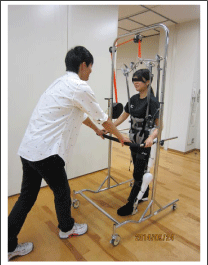
Figure 5: Gait training on the floor with BWSW.
BWSW: body-weight supported walker.
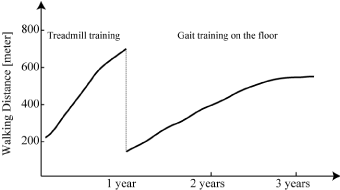
Figure 6: The time course of walking distance during gait training.
Walking distance: The distance that the patient walked during training before
his heart rate reached 125 bpm.
Pre-training
(initial evaluation)
Post-training
(3 years later)Body weight (kg)
56
54
BMI
20.8
20.1
ROM (°)
Hip extension (R/L)
-30/-20
-25/-20
Knee extension (R/L)
-20/-15
-20/-15
Ankle dorsiflexion(R/L)
-25/-25
-25/-20
MMT
Hip extension (R/L)
2-/2-
2-/2-
Knee extension (R/L)
2-/2-
2-/2-
Shoulder flexion (R/L)
2/2
2/2
Shoulder extension (R/L)
2/2
2/2
Elbow extension (R/L)
3/3
3/3
Brook upper extremity scale
2
2
Vignos lower extremity scale
9
9
Table 2: Results of clinical assessments. BMI, body mass index; ROM, range of motion; R/L, Right/Left; MMT, manualmuscle testing.
Discussion
This case report describes the feasibility of HAL gait training for patients with BMD. In general, patients with neuromuscular disease do not undergo gait training during the non-ambulatory phase [12]. This patient had not undergone gait training since he had become wheelchair-bound. Although there are no standard exercises for patients with BMD or severe Duchenne muscular dystrophy [13], his gait ability and fitness improved with HAL gait training. This finding indicates that HAL gait training is both feasible and safe when used as a part of a regular rehabilitation program for patients with BMD.
All gait trainings were performed using BWSW, which provided safety and gait speed control. The combined use of the HAL and BWSW is important for HAL gait training in patients with BMD. The combination allowed the patient to stop walking whenever he wanted. Although the BWSW height occasionally limited the reduction of weight load, it was satisfactory in the present case. The use of a harness seems essential to allow safe HAL gait training for patients with BMD.
The HAL training began long after the patient became wheelchairbound. HAL gait training at an early phase may be necessary to prevent lower limb muscle weakness or joint contracture due to disuse syndrome as described in other conditions [9]. In the present case, the training frequency was relatively limited (once a week, Table 1). Furthermore, other physical exercises, such as knee extension exercise with HAL, were not performed. Other physical functions, such as muscle strength and range of motion, may be recovered by additional HAL trainings. Finally, improvement was not observed in the clinical assessment (Table 2). Other medication should be combined with HAL gait training to achieve clinical improvement. Further study is needed in this area.
Conclusion
For patients with BMD, HAL gait training may be an effective rehabilitation tool.
Acknowledgment
The authors would like to thank Enago (www.enago.jp) for the English language review.
References
- Emery AE, Skinner R . Clinical studies in benign (Becker type) X-linked muscular dystrophy. Clin Genet. 1976; 10: 189-201.
- Emery AE . The muscular dystrophies. Lancet. 2002; 359: 687-695.
- Kawamoto H, Sankai Y: Power assist method based on Phase Sequence and muscle force condition for HAL.Adv Robot2005, 19: 717-734.
- Maeshima S, Osawa A, Nishio D, Hirano Y, Takeda K, Kigawa H,et al . Efficacy of a hybrid assistive limb in post-stroke hemiplegic patients: a preliminary report. BMC Neurol. 2011; 11: 116.
- Sakakima H, Ijiri K, Matsuda F, Tominaga H, Biwa T, Yone K, et al: A newly developed robot suit hybrid assistive limb facilitated walking rehabilitation after spinal surgery for thoracic ossification of the posterior longitudinal ligament: a case report.Case Rep Orthop 2013, 2013: 621405.
- Kubota S, Nakata Y, Eguchi K, Kawamoto H, Kamibayashi K, Sakane M, et al . Feasibility of rehabilitation training with a newly developed wearable robot for patients with limited mobility. Arch Phys Med Rehabil. 2013; 94: 1080-1087.
- Kawamoto H, Kamibayashi K, Nakata Y, Yamawaki K, Ariyasu R, Sankai Y, et al . Pilot study of locomotion improvement using hybrid assistive limb in chronic stroke patients. BMC Neurol. 2013; 13: 141.
- Ueba T, Hamada O, Ogata T, Inoue T, Shiota E, Sankai Y . Feasibility and safety of acute phase rehabilitation after stroke using the hybrid assistive limb robot suit. Neurol Med Chir (Tokyo). 2013; 53: 287-290.
- Nilsson A, Vreede KS, Häglund V, Kawamoto H, Sankai Y, Borg J . Gait training early after stroke with a new exoskeleton - the hybrid assistive limb: a study of safety and feasibility. J Neuroeng Rehabil. 2014; 11: 92.
- Takeshima Y, Yagi M, Okizuka Y, Awano H, Zhang Z, Yamauchi Y, et al: Mutation spectrum of the dystrophin gene in 442 Duchenne/Becker muscular dystrophy cases from one Japanese referral center.J Hum Genet 2010, 55: 379-388.
- Aach M, Cruciger O2, Sczesny-Kaiser M3, Höffken O3, Meindl RC2, Tegenthoff M3, et al . Voluntary driven exoskeleton as a new tool for rehabilitation in chronic spinal cord injury: a pilot study. Spine J. 2014; .
- Bushby K, Finkel R, Birnkrant DJ, Case LE, Clemens PR, Cripe L, et al . Diagnosis and management of Duchenne muscular dystrophy, part 1: diagnosis, and pharmacological and psychosocial management. Lancet Neurol. 2010; 9: 77-93.
- Bushby K, Finkel R, Birnkrant DJ, Case LE, Clemens PR, Cripe L, et al . Diagnosis and management of Duchenne muscular dystrophy, part 2: implementation of multidisciplinary care. Lancet Neurol. 2010; 9: 177-189.